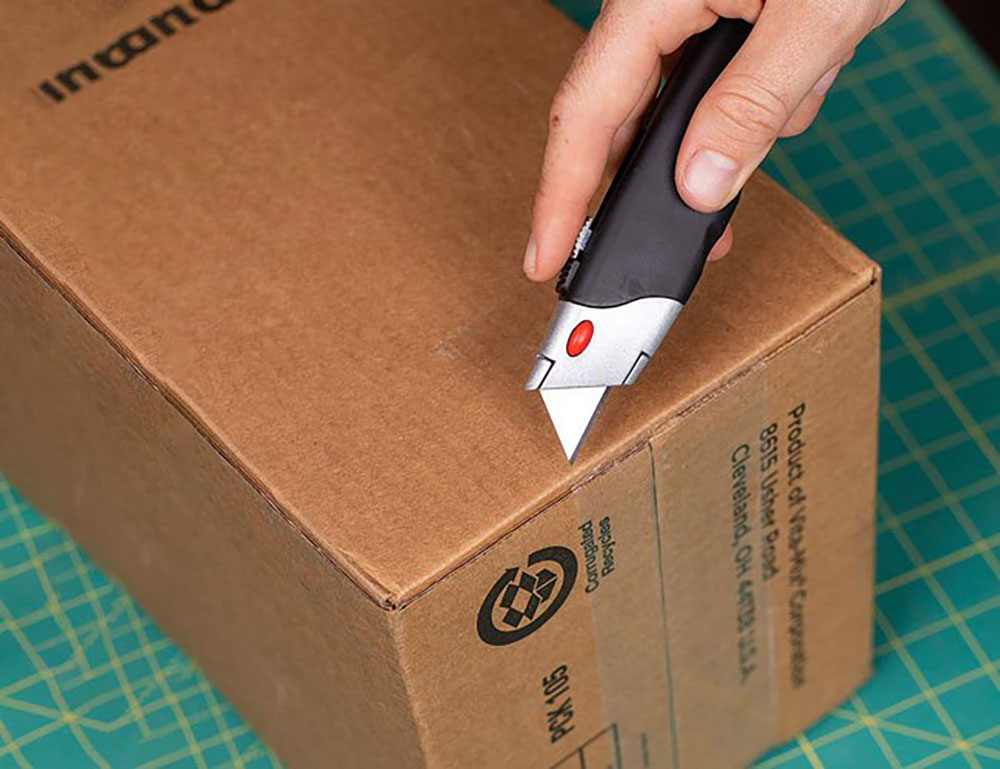Advertisement
When thinking of box cutters in the office, you conjure up images of workers in an industrial or construction setting. You seldomly think about traditional office workers needing a blade like that, but there are times when office workers might need access to a box cutter too.
Having a box cutter for the office is an excellent way to manage simple manual tasks. This compact cutting utility is commonly used to open and separate bulky or large items. But before you start using one, let’s elaborate on how they are commonly used in an office space, what types of box cutters are available, and how to use this cutting utensil safely.
Uses for Box Cutters in the Office

Incoming and outgoing packages are in constant rotation in a mailroom, and there will definitely need to be tools to get those packed up and/or shipped out. When opening packages sent to the office, having a box cutter handy can make opening them more manageable.
They are also suitable for cutting zip ties and plastic shrink wrap. Although scissors are commonly used, box cutters tend to be safer, and are easier to hold and keep on hand for pocket use. Scissors tend to be pointy and are safer to leave in a drawer.
Types of Box Cutters for Office Use
Box cutters come with different blade types that work well in office conditions. While some are more common than others, having options can ensure you have the right tool for the job.
Pointed Tip Blades
Pointed tip blades are the most common blade found on a box cutter. The tip allows you to puncture the item before making the cut. This type of knife works well on plastic, fabric, and drywall.
Rounded Tip Blades
Rounded tip blades are marginally safer than pointed tipped edges. They usually eliminate the possibility of accidentally cutting yourself. As there is no sharp tip to puncture the material before cutting, these edges are for softer materials such as cardboard or foam.
Serrated Edge Blades
Serrated edge blades are designed for cutting through items that are hard on the outside and soft on the side, often bread, fruits and vegetables. They also come in handy for ropes and fabric. You use it in a sawing motion instead of a straight cutting motion. A sawing movement helps to build up momentum to make it easier to cut.
Hook Blades
A box cutter with a hooked blade is ideal for cutting through heavy-duty materials. They are usually used by roofers or flooring experts. These blades are suitable for cutting through linoleum, shingles, and carpet. However, they work well at cutting through thick cardboard.
Snap-Off Blades
Snap-off blades usually have pointed tips and can be used similar to pointed-edged blades. The difference is they are sectioned so that once the edge dulls, you can break off the piece to get a new sharp edge.
Scallop Edge Blades
Scallop edge blades are similar to serrated edged versions. However, scallop blades are often used in the kitchen because they are perfect for cutting fruits and vegetables. They are also suitable for cutting memory foam because it gives you a smooth edge.
Auto-Retracting Blades
Auto-retracting blades usually have a straight edge, and can be either pointy or have a round tip. These utility knives pull the blade back in if you release the button or the edge loses contact with the cutting surface. They are safer than manual retracting or fixed blade box cutters, and you don’t have to remember to retract the blade or put the cap on.
Manual Retracting Blades
A manual retracting blade also brings the edge into the housing. However, unlike auto-retracting knives, you have to manually pull or push the button on the side to close it.
Safety Precautions
One of the most common work injuries is lacerations made by box cutters. To use a box knife safely, you should follow OSHA guidelines concerning utility knives. Injuries in the workplace occur when a blade is left in an open position (i.e., not retracted into the housing or the cap is left off). Injuries also occur when the worker cuts with a knife, and it slips, cutting into an arm, leg, or other body part. Dull blades are also a safety hazard.
Inspect the Box Cutter Before You Use It
Before you begin cutting anything with a utility knife, inspect it. If the blade is dull, you want to replace it before using it. If the knife is dull, you will have to put more pressure on the edge, which makes the possibility of it slipping and cutting you or someone else greater.
Keep the Blade Short
Retractable blades don’t have to be extended all the way. The design allows you to adjust the length. Keep it only to the size needed for the cutting task. A shorter blade helps to reduce the risk of injury. Wear gloves when you use the box cutter.
Keep Fingers Out of the Way
Keeping your fingers out of the way might seem like a given. However, it is common for some to hold the box cutter with their fingers wrapped close to the blade. You should make sure the hand holding the knife doesn’t have fingers resting on or near the cutting edge. When cutting, put your free hand away from the cutting area to reduce the risk of accidental lacerations.
Cut Away From You
When at all possible, cut away from your body. Try not to pull the box cutter toward you because it may slip and cause injuries. Whenever you cut, angle the blade away from you. If someone bumps into you while working, the angle of the blade will keep accidental lacerations from occurring.
Box cutters have many different uses in office and home settings. By having the correct type of blade and adhering to proper safety measures, you can ensure the task is complete without incident.

